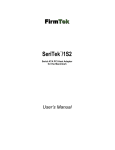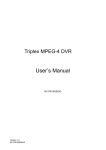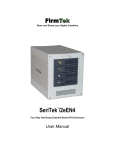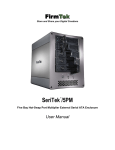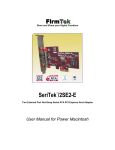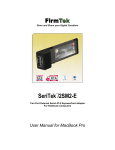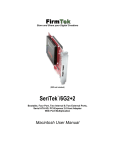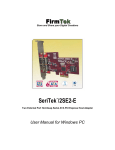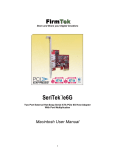Download FirmTek 2-por external User's Manual
Transcript
Store and Share your Digital Creations SeriTek /1VE2+2 ™ 2-Port External, 2-Port Internal Serial ATA PCI-X Host Adapter User Manual for Power Macintosh FirmTek, LLC www.firmtek.com Copyright Copyright © 1998-2005 FirmTek, LLC. All rights reserved. No part of this manual may be reproduced, translated by any means, photocopied, or transmitted in any form without the prior written permission of FirmTek. Trademarks FirmTek, UltraTek, AV-Tek, SeriTek names and logotypes are trademarks of FirmTek, LLC. Apple, Macintosh, Power Macintosh, Mac OS 9.XX, OS X, and the Mac logo are registered trademarks of Apple Computer, Incorporated. The "Built for OS X" graphic is a registered trademark of Apple Computer, Incorporated, and used under license. All other manufacturer product names mentioned in this manual are for identification purposes only and are trademarks or registered trademarks of their respective owners. Changes FirmTek reserves the right to make any changes to product design, specifications, or details without notice. Actual product photos or screenshots may look different from those provided. Notice The material content of this manual is for informational purposes only. It is possible the content of this manual may contain technical inaccuracies, typographical, or other errors. FirmTek assumes no liability for any errors, omissions, or from the use of this manual that may result from such errors, including, but not limited to loss of data or profits. Before installing SeriTek/1VE2+2 or any other hardware or software, you are responsible for backing up data contained on any storage devices. After hardware or software installation, you are responsible for backing up data on any storage devices at frequent intervals. FirmTek, LLC is not liable for any loss of data or damage to equipment resulting from the use of SeriTek/1VE2+2. TABLE OF CONTENTS I. Introduction...................................................................................................1 II. Installing the SeriTek/1VE2+2.....................................................................5 III. Connecting and Formatting Hard Drives....................................................7 IV. Using SeriTek/1VE2+2 Hot-Swap Functionality..................................... 18 V. Troubleshooting......................................................................................... 22 VI. Product Support........................................................................................ 24 VII. Product Warranty and Disclaimers.......................................................... 24 VIII. Regulatory Compliance Statements........................................................ 25 I. Introduction Welcome Congratulations and thank you for purchasing the SeriTek/1VE2+2 Serial ATA host adapter. This product is yet another innovative solution from the innovative folks at FirmTek. About This User Manual This User Manual was written with the assumption you are familiar with your Power Macintosh computer, and are comfortable with opening its case. For further information, and to get acquainted with your computer, please refer to your Power Macintosh User Manual. About Serial ATA Technology An evolutionary replacement for Parallel ATA, Serial ATA (Advanced Technology Architecture) is an interface that allows you to add hard drives and peripherals to your Macintosh. Serial ATA offers insulated cables that are thinner and longer with smaller 7-pin connectors which results in easier installation and improved airflow, compared to wider and shorter Parallel ATA cables. Improved airflow translates into a cooler operating environment for your Power Macintosh. About the SeriTek/1VE2+2 Serial ATA PCI Host Adapter The SeriTek/1VE2+2 Host Adapter provides an easy and affordable way for Macintosh users to add inexpensive, high-speed storage. With two external Serial ATA ports, and two internal Serial ATA ports, each offering 1.5Gbits/sec performance, the SeriTek/1VE2+2 provides the high bandwidth to meet the needs of performance-hungry applications. The SeriTek/1VE2+2 is PCI-X compatible, permitting Power Mac G5 users to take advantage of the latest extended PCI technology while maintaining backward compatibility with older Power Macintosh systems. About PCI-X Technology PCI-X (Peripheral Component Interconnect Extended) is a new PCI bus technology that increases the speed data can move within the Power Mac G5 from 66 MHz to 133MHz. With PCI-X, the amount of data exchanged between the CPU and expansion cards is increased from 532MB/sec to 1.06GB/sec. PCI-X is also backward-compatible, which allows users to install a PCI-X card such as the SeriTek/1VE2+2 host adapter into a standard PCI slot, allowing the card to match the speed and performance characteristics of the slot it was inserted into. With four 1.5Gb/sec Serial ATA ports, the SeriTek/1VE2+2 host adapter maximizes the use of the PCI bus in older Power Macintosh computers, allowing the PCI bus to run at its fullest potential. Package Contents • • • SeriTek/1VE2+2 SATA host adapter board Two 60cm internal data cables User Manual on CD-ROM -1- SeriTek/1VE2+2 Key Features and Benefits • • • • • • • • • • • • • • • • • • • Two external shielded Serial ATA ports with exclusive hot-swap capability Two internal Serial ATA ports Plug-and-Play ease of use Completely self-contained booting functionality, no driver installation necessary Boosts overall system performance with per-port data transfer rates of up to 150MBytes/sec or 1.5Gbits/sec Supports Power Mac G5 PCI-X ( Peripheral Component Interconnect Extended) bus Compatible with all PCI-based Power PC Macintosh computers Supports Mac OS 9, and OS X version 10.1.5 or later Provides performance and protection: Supports native OS X RAID 0/1; OS 9 RAID with 3rd party software User-upgradeable firmware 48-bit LBA support for drive sizes larger than 137GB Perfect for upgrading and expanding legacy and G5 Macintosh computers PCI-X 1.0a compliant 64-bit at 133/100/ 66MHz bus speeds Backward compatible with standard 32/64-bit PCI at 33MHz and 66MHz bus speeds Direct Port Access: Enhanced performance by allowing data transfer to all four drives simultaneously Bus master operation enhances multitasking during disk transfers and increases CPU efficiency: The CPU is free to handle other tasks during data transfers between the PCI Bus and system memory Data protection: Supports OS X RAID, OS 9 Software RAID (third party software), and other storage utilities Reduced setting on storage devices (no master/slave) means easier installation and replacement Ideal for a variety of Power Macintosh applications: Desktop publishing, Audio/Video storage and editing, photo/graphics storage and editing, servers, and gaming. Serial ATA Hard Drive Compatibility Note: Early Hitachi Serial ATA hard drives are incompatible with the SeriTek/1VE2+2 Host Adapter. This is due to a seldom -used Serial ATA feature called SSC, which is enabled on these hard drives. The SeriTek/1VE2+2 does not support this feature. Newer model Hitachi Serial ATA hard drives should be compatible with SeriTek/1VE2+2. Check FirmTek’s website at www.firmtek.com for the latest compatibility information. At the time this manual was written, the following Hitachi Deskstar hard drives have the SSC feature disabled, and are compatible with the SeriTek/1VE2+2 host adapter: Model 7K500 (500GB) - Part Number HDS725050KLA360 Model 7K400 (400GB) – Part Numbers 0A30984 and 0A30985 Model 7K250 (250GB) – Part Number 0A30340 Model T7K250 (250GB) – Part Number HDT722525DLA380 Model 7K250 (160GB) – Part Number 0A30339 Model T7K250 (160GB) – Part Number HDT722516DLA380 Model 7K250 (120GB) – Part Number 0A30338 Model 7K250 (80GB) – Part Number 0A30337 Model 7K80 (80GB) – Part Number HDS728080PLA380 Model 7K80 (40GB) – Part Number HDS728040PLA320 Other Serial ATA hard drives from manufacturers such as Maxtor, Seagate, and Western Digital do not have this feature enabled by default and are therefore compatible. -2- SeriTek/1VE2+2 Specifications General System Hardware Requirements Operating Systems Supported Bus Types External Connectors Drive Types Supported ATAPI Device Support Data Transfer Rates Drive Modes Supported Advanced Data Features Onboard Flash ROM Cables Supported Warranty Physical Dimensions Power Requirements • PCI based Power Macintosh with available PCI expansion slot • PCI-X 1.0a compliant 64-bit at 133/100/ 66MHz bus speeds. Backward compatible with standard 32/64bit PCI at 33MHz and 66MHz bus speeds. • Mac OS 9.xx • Mac OS X version 10.1.5 or later (works best with 10.2 or later) • 32/64 bit, 33/66MHz PCI • 133/100/66MHz PCI-X • Compliant with PCI bus version 2.2 • Compliant with PCI-X bus version 1.0a • 2 shielded external, 2 internal Serial ATA (SATA) interface connectors support up to 2 external hard drives and 2 internal hard drives • Serial ATA hard drive • Backward compatible with Ultra DMA 133/100/66 hard drives* • Yes* • Up to 150 MBytes/second or 1.5Gbits/second burst data transfer rate • Serial ATA • UltraDMA modes 6/5/4/3/2/1/0 • Fully compliant with Serial ATA 1.0a specification • Bus Mastering off-loads data I/O handling from CPU • Complete 32-bit CRC error checking, for all bits transmitted (command, data, and status), offers enhanced data protection for high-speed Serial ATA drives • Four independent data channels allows for separate device timings • Automatically identifies and configures drive types* • Automatically detects and supports devices utilizing many transfer modes including UltraDMA 6/5/4/3/2/1/0 • Allows easy upgrades to the latest firmware • 7-pin SATA cable • Two year limited parts & labor • 163mm(L) x 1.6mm(W) x 64.4mm(H) (not including bracket) • 5V ± 5% • Temperature: Operating: +5°C to +55°C Non-Operating: -25°C to +70°C Environmental • Relative humidity: Operating: 20% to 80% Non-Operating: 15% to 90% • EN55022/1998, EN55024/1998 (European EMC Compliance Community) • FCC Part 15 Class B (US) * IDE to Serial ATA converter module required for Parallel ATA and Ultra ATA133/100/66 drives -3- SeriTek/1VE2+2 System Requirements Operating System • • Macintosh OS 9.XX Macintosh OS X version 10.1.5 or later Hardware Requirements • • Power Macintosh with available PCI or PCI-X expansion slot External powered enclosure equipped with Serial ATA hard drive(s) or Parallel ATA hard drive(s) (Parallel ATA hard drives require compatible Serial ATA to Parallel ATA converters contained within the enclosure) Materials Required • Standard medium -sized Phillips screwdriver -4- II. Installing the SeriTek/1VE2+2 Caution: Prior to installing the SeriTek/1VE2+2 host adapter and hard drive(s) or peripheral(s), please make sure your data is backed up. The SeriTek/1VE2+2 host adapter and your Macintosh contain sensitive components that can be permanently damaged by Static Electric Discharge. Be sure you are working in an area free of static electricity to prevent them from being damaged. Use a wrist grounding strap if you have one or regularly touch a metal part of the computer chassis such as the power supply case or a port access cover to discharge any built-up static electricity from your body. Make sure to handle the SeriTek/1VE2+2 host adapter by its bracket or around its edges to avoid damage by static electricity. Introduction This section describes the proper method of installing your SeriTek/1VE2+2. SeriTek PCI Host Adapter Installation: 1. Properly shut down your Macintosh and disconnect the AC power cord. 2. Depending on the model of your Macintosh, open the side panel or top cover. On some models, you may need to open an additionalmetal or plastic cover to access the PCI slots. Please refer to your Macintosh User Manual for more information about gaining access to PCI slots and hard drive or peripheral bays. 3. Choose an empty PCI or PCI-X (Power Mac G5) expansion slot where you will install the SeriTek/1VE2+2 host adapter. 4. Remove the screw and detach the PCI expansion port access cover secured to the computer case. 5. Remove the SeriTek/1VE2+2 from its protective materials. Make sure to hold the card around by its bracket or around its edges to avoid touching components which might be damaged by static electricity. 6. Position the PCI card bracket by facing it towards the rear of the computer. Align the gold connectors of the SeriTek/1VE2+2 over the PCI slot and gently press it into the slot until the card is firmly seated. If the card is properly seated, the upper ear of the PCI card bracket should line up with the screw mounting location. 7. Using the same screw that was removed earlier; secure the card to thePower Macintosh computer case (see Figure 1). -5- Caution: The SeriTek/1VE2+2 supports external cables that may be plugged in to one of its two external receptacles. If the SeriTek/1VE2+2 is not properly secured when a cable is inserted into one of the receptacles, it may become loose from the PCI slot and damage the computer. Figure 1: Inserting and securing the SeriTek/1VE2+2 Internal Cable Installation 8. If the Serial ATA hard drive or peripheral uses a newer 15-pin power receptacle and your system provides 15-pin power feeds: Attach the 15-pin power feed directly to the drive’s 15-pin power receptacle. 9. If the Serial ATA hard drive or peripheral uses a newer 15-pin power receptacle and your system does not provide 15-pin power feeds: Attach the 15-pin end of the 4- to 15-pin power adapter provided by your hard drive or peripheral vendor to the drive’s 15-pin power receptacle, and the 4-pin end to an available system power connector. 10. If the hard drive or peripheral provides a legacy 4-pin power connector and your system provides legacy 4-pin power feeds: Connect an available 4-pin system power connector directly to the 4-pin power receptacle on the drive. Note: If your hard drive or peripheral provides both 4-pin and 15-pin power connectors, please do not connect both 4-pin and 15-pin power cables at the same time as this may result in damage to your equipment. 11. Attach one end of the Serial ATA data cable to the Serial ATA hard drive or peripheral, and the other end to an open connector on the SeriTek/1V4. Note: If the Serial ATA cable provided has an angled connector on one end, connect this end to the hard disk or peripheral. This will help to insure the drive and cables will fit properly within the Macintosh chassis. 12. Repeat steps 8 through 11 to install additional hard drives or peripherals. 13. Caution: The Serial ATA data cable has keyed L-shaped 7-pin connectors at each end. Be sure to connect the cable using the proper orientation to the SeriTek/1V4 host adapter and the hard drive or peripheral interfaces. If you are having difficulty connecting the cable, try reversing the orientation of the connector. It should easily snap into place. Please do not force the cable connector onto the host adapter and hard drive or peripheral interface. 14. Close your Power Macintosh computer case and re-attach the AC power cord. Ready for Use Your SeriTek/1VE2+2 host adapter is now installed. The SeriTek/1VE2+2 host adapter features fully self-contained Macintosh booting functionality and will be recognized by your Macintosh computer when you power it on. -6- III. Connecting and Formatting Hard Drives Introduction Up to two internal Serial ATA hard drives may be plugged into the SeriTek/1VE2+2 host adapter. In addition to two internal hard drives, the SeriTek/1VE2+2 supports up to two external hard drives. This section describes how to connect hard drives using external enclosures and a method of formatting your internal and/or external Serial ATA hard drive using Apple’s Drive Setup utility (OS 9.XX) or Apple’s Disk Utility (OS X). If you decide to use a third party drive setup utility, please refer to the documentation provided with the utility. Connecting the SeriTek/1VE2+2 to an External Enclosure Note: Macintosh computers require unique external shielded Serial ATA cables for maximum reliability. FirmTek Serial ATA cables were specially designed to be compatible with both PC and Macintosh computers. Please use only FirmTek external shielded Serial ATA cables with the SeriTek/1VE2+2. 1. The SeriTek/1VE2+2 is compatible with a wide range of external enclosures. Enclosures must meet basic requirements which include: • Adequate power to support the hard drives (dedicated power supply), • L-shaped 7-pin shielded receptacles compatible with FirmTek’s shielded Serial ATA cable • Support for Serial ATA Version 1.0 • Serial ATA hard drives or Parallel ATA hard drives with compatible Serial ATA to Parallel ATA converter 2. Install hard drives into the external enclosure according to the instructions included with the enclosure. 3. Attach one end of FirmTek’s shielded Serial ATA cable(s) to the Serial ATA receptacle(s) on the SeriTek/1VE2+2, and connect the other end(s) to the external enclosure. 4. Power on the external enclosure. Caution: The FirmTek shielded Serial ATA data cable has keyed L-shaped 7-pin connectors at each end. Be sure to connect the cable using the proper orientation to the SeriTek/1VE2+2 hos t adapter and the external enclosure. If you are having difficulty connecting the cable, try reversing the orientation of the connector. It should easily snap into place. Please do not force the cable connector onto the host adapter and hard drive or peripheral interface. -7- Formatting Serial ATA Hard Drives with Macintosh OS 9.XX Caution: Please make sure your data is backed up before attempting to format or change the partition layout of your hard drives. 1. Turn on your Power Macintosh computer. 2. Open Apple’s Drive Setup. To find and open this application: a) Hold down the Command key and press the “F” key simultaneously. b) Type in “Drive Setup” in the field with the blinking cursor c) Press Return key (See Figure 2). Figure 2: Finding Apple's Drive Setup Utility -8- 3. Locate and double click on the Drive Setup “application program” utility (see Figure 3). Figure 3: Running Apple's Drive Setup Utility -9- 4. When the list of hard drives appears, carefully select the drive you wish to format by clicking on it (See Figure 4). If this is a new, unformatted drive, it may show up as <not initialized>. Note: For ideal performance and compatibility, SeriTek/1VE2+2 uses SCSI emulation which allows your Serial ATA drive to appear as a SCSI drive. Figure 4: Example of selecting a drive to format -10- 5. Click the Initialize button to format the hard drive (see Figure 5). As an alternative, you may use the Custom Setup option if you are comfortable with customizing the hard drive’s partition layout. For more details on the Custom Setup option, please refer to your Power Macintosh User Manual. Figure 5: Initializing the Hard Drive 6. After the hard drive is successfully initialized, it should appear on the desktop as “untitled.” 7. The hard drive may be renamed by selecting the word “untitled” and typing your own name or description for your new drive. 8. Repeat steps 4 through 7 if you wish to format additional hard drives connected to SeriTek/1VE2+2. 9. Select the File pull-down menu within Apple’s Drive Setup utility and choose Quit to exit the application -11- Formatting Serial ATA Drives Using Macintosh OS X Version 10.1.5 or Later 1. Turn on your Macintosh computer. 2. Open Apple’s Disk Utility which is located in the Utilities folder of the Macintosh OS X start-up volume. To open this application: a) Double click the Mac OS X startup volume b) Double click the Applications folder c) Double click the Utilities folder d) Double click the Disk Utility icon (See Figures 6 and 7 for examples) Figure 6: Locating Apple’s Disk Utility Figure 7: Alternate method for locating Apple’s Disk Utility -12- 3. Review the list of hard drives show within Disk Utility (see Figure 8). Drives currently in use should have a list of volume names below it. New, unformatted drives typically have no volume names listed. Carefully select the drive you wish to format. Note: Some versions of Apple Disk Utility incorrectly display Serial ATA hard drives as having the Connection Type of “Slave.” Serial ATA hard drives are all in fact “Master” drives. Later versions of Apple Disk Utility correctly display Serial ATA hard drives as “Master.” If your Serial ATA hard disk is lis ted as “Slave,” don’t worry, its performance will not be affected. Figure 8: Example hard drive listing -13- 4. After carefully selecting the hard drive you wish to format, select the Erase tab in Apple’s Disk Utility (see Figure 9). Figure 9: Selecting the Erase tab in Apple’s Disk Utility 5. For Volume Format, the most common choice is “Mac OS Extended.” 6. In the Name field, you may type a name of description for your new hard drive. 7. If you wish to have your new hard drive be recognized by Mac OS 9.XX, select the Install Mac OS 9 Drivers checkbox. Users who dual-boot both Mac OS 9.XX and Mac OS X 10.2 and later may want to select this option. This will allow the formatted volume to be recognized by both Mac OS versions. 8. Click the Erase button to format the hard drive. 9. Once the hard drive is initialized, it will be depicted as an icon on your Mac OS X desktop. -14- Creating a RAID Volume with Serial ATA Hard Drives Using Macintosh OS X version 10.2 or Later The Mac OS X 10.2 or later RAID (Redundant Array of Inexpensive Disks) capability allows you to increase volume sizes, provide data redundancy in case of a hard drive failure, or increase performance by allowing you to join multiple drives into a single volume. Two RAID types are supported, Stripe and Mirror. A volume that is striped (also known as RAID 0) has its data broken up and spread across multiple hard drives. Read/write performance, especially for sequential access, is improved when the data is readand written across multiple drives simultaneously. No data integrity is provided with striping however, and since data is spread across multiple drives, if one of the hard drives fails, all of the volume’s data will be lost. A volume that is mirrored (also known as RAID 1) has its data duplicated from one hard drive onto another. A mirrored volume offers data integrity and immediate access to data in the event one hard drive fails. Because data is mirrored and duplicated across two hard drives, only half of the combined capacity of the two drives is available. 1. Turn on your Macintosh computer. 2. Open Apple’s Disk Utility which is located in the Utilities folder of the Macintosh OS X start-up volume. To open this application: a) Double click the Mac OS X startup volume b) Double click the Applications folder c) Double click the Utilities folder d) Double click the Disk Utility icon (See Figures 6 and 7 for examples) 3. Review the list of hard drives show within Disk Utility (see Figure 8). Drives currently in use should have a list of volume names below it. New, unformatted drives typically have no volume names listed. 4. Select the RAID tab in Apple’s Disk Utility (see Figure 10). Figure 10: Selecting the RAID tab in Apple’s Disk Utility -15- 5. Carefully select and drag a hard drive to add as a member of the new RAID volume onto the Disk status window. 6. Repeat step 5 for each member for the RAID volume. 7. Choose a RAID Scheme: Stripe or Mirror. 8. Name the new RAID volume. 9. For Volume Format, the most common choice is “Mac OS Extended” (See Figure 11). Figure 11: Example drives and options for a RAID volume -16- 10. After reviewing the options you selected, click on the Create button to initialize the new RAID volume (see Figure 12). Figure 12: Creating a new RAID volume 11. After the RAID volume is successfully initialized, it should appear on the desktop. -17- IV. Using SeriTek/1VE2+2 Hot-Swap Functionality Introduction The SeriTek/1VE2+2 provides advanced hot-swap functionality which provides flexibility similar to that of Universal Serial Bus (USB) and FireWire without the burden of having to power down your system when adding or removing hard drives. Using a unique patentpending method, SeriTek/1VE2+2 supports RAID hot-swap disks under both Mac OS 9 and OS X. Note: Both the internal and external sets of ports of the SeriTek/1VE2+2 support hot-swap functionality. However, for safety reasons your Power Macintosh computer case should be closed when the computer is being operated, and swap external hard drives using the two external ports only. Hot-Swap Guidelines • Do not disconnect or remove hard drives while transferring data. • Save your work and close associated applications before removing the external hard drive (applications need to be closed since they may keep temporary working files open on the external hard drive). • Always unmount the volumes (eject or drag the volumes to trash) associated with an external hard drive before removing it. • As a general rule, power down the external hard drives after powering down the Macintosh computer. Power on the external enclosure before powering on the Macintosh computer. • The SeriTek/1VE2+2 hot-swap functionality is designed to provide RAID-based volume spanning among four hard drives with one SeriTek/1VE2+2 host adapter. Future SeriTek/1VE2+2 firmware may provide the ability to support RAID volumes that span hard drives among multiple SeriTek/1VE2+2 host adapters. • If RAID volumes span internal and external hard drives, do not attempt to remove and insert external hard drives that partially support the RAID volume or data loss may occur. An example is a RAID volume that spans hard drives plugged into an internal SeriTek/1V4 host adapter within the Macintosh chassis and hard drives plugged into an external SeriTek/1VE2+2 host adapter and external enclosure. Hot-Swap Procedure The hot-swap procedure is the same for both Macintosh OS 9.XX and 10.1.5 and later. The example dialog boxes below are from OS X. OS 9.XX dialog boxes are similar. Connecting External Hard Drive(s) If your Macintosh computer is not yet powered on, power on the external enclosure then power on the computer. If the Macintosh computer is already powered on, you may connect the external hard drive(s). When you connect the first hard drive, you will see a “SATA Configuration Changed” window (See Figure 13). If this is the only hard drive you connect, you may select “OK” in the dialog box. If you have an additional hard drive to connect, connect it and then s elect “OK” in the dialog box. -18- Figure 13: Connecting External Hard Drive(s) Verifying Hard Drive Connections Once you have connected the external hard drive(s) a dialog box will appear which verifies how many devices were added to the system (See Figure 14). There are four Serial ATA channels on the SeriTek/1VE2+2: 0,1,2,3. Channels 0 and 1 are the external ports, channels 2 and 3 are the internal ports . One or more dialog boxes will appear verifying which drive was attached to which channel (See Figures 15 and 16). Figure 14: Device(s) Attached to Channel(s) 0 and/or 1 Figure 15: Example Serial ATA hard drive connected to channel 0 Figure 16: Example Serial ATA hard drive connected to channel 1 -19- Removing External Hard Drive(s) Caution: To prevent loss of data, s ave your work and close associated applications before removing the external hard drive (applications need to be closed since they may keep temporary working files open on the external hard drive). Always unmount the volumes (eject or drag the volumes to trash) associated with an external hard drive before removing it. Eject or drag all of the volumes associated with the hard drive(s) before disconnecting or removing them. When removing a hard drive you will see a “SATA Configuration Changed” window (See Figure 17). If this is the only hard drive you remove, you may select “OK” in the dialog box. If you have an additional hard drive to remove, remove it and then select “OK” in the dialog box. Figure 17: Removing External Hard Drive(s) One or more dialog boxes will appear verifying which drive was attached to which channel (See Figure 18). Figure 18: Example Serial ATA hard drive removed from channel 0 -20- Improperly Removing External Hard Drive(s) Caution: To prevent loss of data, s ave your work and close associated applications before removing the external hard drive (applications need to be closed since they may keep temporary working files open on the external hard drive). Always unmount the volumes (eject or drag the volumes to trash) associated with an external hard drive before removing it. If you do not properly unmount volumes before removing the associated hard drive(s), a “Device Removal” dialog box will appear (See Figure 19). This dialog box shows up as a reminder to unmount volumes properly before disconnecting or removing external hard drives. Failure to properly unmount volumes before disconnecting external hard drives may result in lost data. Figure 19: Improperly removing External Hard Drive(s) Connecting and Immediately Removing External Hard Drive(s) If you connect an external hard drive, then remove it without acknowledging it has been added to the system, a dialog box will appear that explains no new hard drive(s) were detected (See Figure 20). Figure 20: Connecting and Disconnecting an External Hard Drive(s) -21- V. Troubleshooting • The SeriTek/1VE2+2 host adapter does not seem to be recognized Check the SeriTek/1VE2+2 adapter by ensuring it is properly seated in the PCI slot on the Macintosh motherboard. • My hard drive or peripheral won’t work Check cables and connections. Ensure the 7-pin Serial ATA cable is properly oriented to the connectors on the SeriTek/1VE2+2 host adapter and the external enclosure. Ensure the hard drives in the enclosure are properly powered. • Apple’s Drive Setup utility (OS 9.XX) or Disk Utility (OS X) does not display the Serial ATA hard drive or peripheral After checking the cables, connections, and the external enclosure power advanced users may use the Apple System Profiler to determine whether your Macintosh computer recognizes if the SeriTek/1VE2+2 is properly seated in a PCI slot and operating properly. Apple System Profiler under Mac OS 9 1. Open the Apple System Profiler by clicking on the Apple icon to pull down the Apple menu and selecting Apple System Profiler. 2. Select the Devices and Volumes tab. 3. In the in the PCI section, (See Figure 21). 4. In the PCI section, SeriTek/1VE2+2 should show up as a “SCSI card” (see Figure 22). Figure 21: Example SeriTek/1VE2+2 depicted in Apple System Profiler 5. If SeriTek/1VE2+2 is not listed, shut down your Macintosh computer and try re-seating it in the PCI slot by removing and reinserting it. Repeat steps 1 through 3. If the SeriTek/1VE2+2 still doesn’t show up in the Apple System Profiler, try moving it to another PCI slot. -22- Apple System Profiler under Mac OS X 1. Open the Apple System Profiler by clicking opening the Finder, opening Applications, opening the Utilities folder, and double clicking on Apple System Profiler. 2. Select the Devices and Volumes tab (early OS X version) or open Hardware and select PCI/AGP Cards (See Figure 23). Figure 22: SeriTek/1VE2+2 listed under PCI/AGP Cards 3. Under PCI/AGP Cards section, SeriTek/1VE2+2 should show up as an “ata” card type. 4. If SeriTek/1VE2+2 is not listed, shut down your Macintosh computer and try re-seating it in the PCI slot by removing and reinserting it. Repeat steps 1 through 3. If the SeriTek/1VE2+2 still doesn’t show up in the Apple System Profiler, try moving it to another PCI slot. • The transfer rate on my Power Macintosh 8500 seems less than the Serial ATA specified maximum of 150Mbytes/sec. Early Power Macintosh computers, typically built before the “beige G3” was available, have limited hardware resources. These limited resources severely limit data transfer rates of many storage technologies, including Serial ATA. • Does the SeriTek/1VE2+2 work with all Power Macintosh computers? No, SeriTek/1VE2+2 only works with Power Macintosh computers with at least one PCI slot available. If your system lacks PCI slots you cannot use SeriTek/1VE2+2. • My older Parallel ATA hard drives and peripherals have jumper settings. However I can’t find jumper settings on my new Serial ATA hard drive or peripheral. How can I set it to Master or Slave; is there any way to set the SCSI ID? Serial ATA hard drives and peripherals are internally configured as Master drives. Only one drive can be attached to each Serial ATA bus/connector. There is no need to change settings on either the drive or the controller. • I have an old Parallel ATA drive which I am trying to use with a Parallel ATA to Serial ATA converter, but it doesn’t seem to work. Some older Parallel ATA drives do not comply with current ATA standards. Parallel ATA to Serial ATA converters cannot recognize such drives. -23- VI. Product Support Technical Support For additional information on how to use SeriTek/1VE2+2, download the latest firmware updates, or for technical assistance, please visit us at www.firmtek.com , or email us at [email protected]. Please provide the following information when contacting us: Product model and serial number • Firmware version (You may use the Apple System Profiler as described in the troubleshooting section to determine the firmware version. Look for ROM# and Revision #) • Macintosh model • Macintosh OS type and version (example: Mac OS X, version 10.2) • Hardware and software installed on your system • Contact information including daytime telephone number and email address • A detailed description of the question or problem Return Merchandise Authorization If FirmTek technical support determines the product needs to be repaired or replaced, a Return Merchandise Authorization (RMA) number and shipping address will be provided. Please pack in the original shipping container all of the original packaging - including the static bag, all hardware, software, cables, and other accessories that came with the original product. You are responsible for shipping and insurance costs, and any damage incurred due to improper packaging or transport. FirmTek reserves the right to determine whether the product is to be repaired or replaced with new or refurbished parts, or with a new or refurbished product. Standard United States return shipping charges will be paid by FirmTek. Foreign and other shipping methods such as express shipping are available for an additional charge. Write down the RMA number on the outside of the shipping container, and include the following information with the shipment: • A description of the problem • A copy of the original purchase invoice • Return shipping address • Contact information including daytime telephone number and email address FirmTek, LLC reserves the right to refuse shipments missing a valid RMA number. VII. Product Warranty and Disclaimers FirmTek warrants to the original buyer only that this product shall be free from defects in material and workmanship for a period of 2 years from the original date of purchase. This warranty is valid only when the original purchase invoice is provided. This warranty shall not apply to any defects resulting from improper handling, misuse, misapplication, abuse, or unauthorized modification(s) which are performed by end user. FirmTek, LLC reserves the right to make changes to any products described in this manual at any time without notice. FirmTek, LLC assumes no responsibility for the use or reliability of hardware or software that is not supplied by FirmTek, LLC or its affiliated companies. FirmTek, LLC does not assume any responsibility or liability arising out of the application or use of any product described in this document, except as expressly agreed to in writing by FirmTek, LLC; nor does the purchase or use of a product from FirmTek, LLC convey a license under any patent rights, copyrights, trademark rights, or any other intellectual property rights of FirmTek, LLC or third parties. -24- VIII. Regulatory Compliance Statements Federal Communications Commission Radio Frequency Interference Statement WARNING: Changes or modifications to this unit not expressly approved by the party responsible for compliance could void the user’s authority to operate the equipment. This equipment has been tested and found to comply with the limits for a Class B digital device, pursuant to Part 15 of the FCC rules. These limits are designed to provide reasonable protection against harmful interference in a residential installation. This equipment generates, uses, and can radiate radio frequency energy, and if not installed and used in accordance with the instruction manual, may cause harmful interference to radio communications. However, there is no guarantee that interference will not occur in a particular installation. However, if this equipment does cause interference to radio or television equipment reception, which can be determined by turning the equipment off and on, the user is encouraged to try to correct the interference by one or more of the following measures: • Reorient or relocate the receiving antenna. • Increase the separation between equipment and receiver. • Connect the equipment to an outlet on a circuit different from that to which the receiver is connected. • Consult the dealer or an experienced radio/television technician for help. • Use a shielded and properly grounded I/O cable and power cable to ensure compliance of this unit to the specified limits of the rules. This device complies with part 15 of the FCC rules. Operation is subject to the following two conditions: (1) this device may not cause harmful interference and (2) this device must accept any interference received, including interference that may cause undesired operation. CE European Union Compliance Statement EMC compliance: Emissions: EN55022: 1998, Class B Immunity: EN55024: 1998 EN61000-4-2: 1995+A1: 1998 EN61000-4-3: 1995+A1: 1998 EN61000-4-4: 1995 EN61000-4-6: 1996 EN61000-4-8: 1993 SeriTek/1VE2+2 TSLKC2KE0526 -25-




























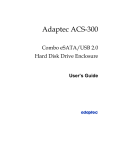

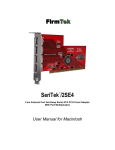
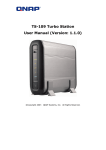
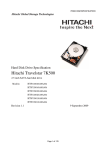
![Manual del usuario - [ [ [ ANSEL ] ] ]](http://vs1.manualzilla.com/store/data/006306298_1-4b727a9f513ab88544573091f86e1211-150x150.png)
